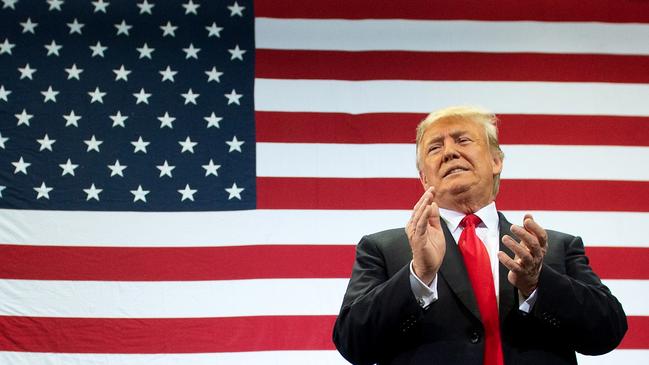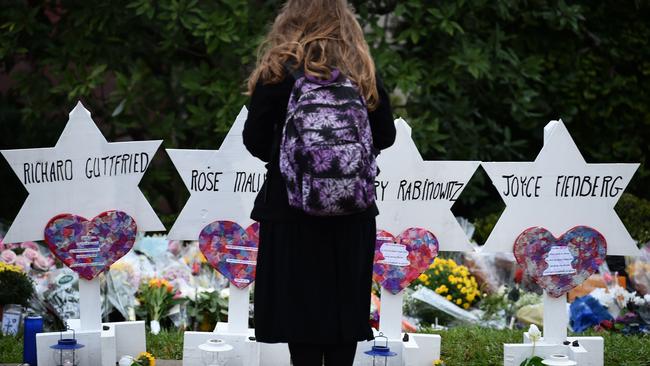Identity politics is tearing the US apart
The United States has suffered many periods of civil conflict but this time there’s no obvious hope of a resolution.

Bernice and Sylvan Simon loved the country that allowed them, as Jewish immigrants from Germany, to worship and live as they chose. The front door of their home in Pittsburgh sported three stickers: “Support Our Troops”, “God Bless America” and “America The Beautiful”.
Last Saturday Mr and Mrs Simon were shot dead at their synagogue. The name of their alleged murderer, Robert Bowers, an otherwise unmemorable man, will live on as yet another footnote in the long and baleful history of antisemitism.
The murder of the Simons and nine other worshippers at the Tree of Life synagogue was the worst act of antisemitic violence in US history, apparently carried out by a man who claimed Jews were trying to eliminate white Americans through mass immigration. Their deaths came at the end of a week in which two black men were killed in Kentucky by a white gunman with a history of racist behaviour, and a Florida man was accused of mailing what seemed to be explosive devices to a dozen or more leading Democrats and critics of President Donald Trump.
The questions on every American’s restless mind right now are: How bad is it? How much worse will it get? The verbal rancour of the past few years has steadily intensified and often seems close to boiling over into something much worse.
The events of the past week, along with a political climate defined by a president who openly abuses and derides his opponents, make many wonder whether we have already reached the point at which the country could literally, not figuratively, tear itself apart.

America’s current dysphoria looks especially grim but it has endured worse periods of strife. Even as they created their republic 230 years ago, the founding fathers understood the stresses that could tear a nation apart and recognised the social fragility of the foundations on which they built it. They created a system with just the right combination of flexibility and rigidity to survive occasional crises. Now that system is being put to the test.
What’s curious, and perhaps unique, about this crisis is that it’s happening at a time of relatively benign economic and social conditions. Gross domestic product is expanding at its fastest pace in a decade. Unemployment is at a 49-year low. The average worker’s wages, which had been stagnant for two decades, appear to be growing again in spending power. Inflation remains dormant. Violent crime is down by about 50 per cent since it hit its peak in the early 1990s.
Beyond America’s shores, after a decade of bloody war in the Middle East, the US is largely at peace. Between 2003 and 2011 an average of nearly 700 US servicemen and women died in Iraq and Afghanistan every year. So far this year the total is 22.
All this is reflected in a renewal of popular optimism. For most of the past 10 years, a large majority of Americans told pollsters the country was on the wrong track. Those numbers have recently dropped sharply. Just yesterday the Conference Board, a business group that tracks consumer sentiment, reported that confidence was at its highest level since the turn of the century. Of course there are grave challenges such as opioid addiction, widespread inequality, the threat to jobs from technological innovation and unease about the rise of China. But compare this prospectus with some of the most acute periods of American disunion.

In 1998, a spasm of partisanship resulted in the impeachment by Republicans of President Bill Clinton. For all the rancour in Washington, a solid majority of voters never saw the case for his removal and the country moved on.
In the late 1960s and early 1970s, a low-grade civil war over civil rights and Vietnam (where 1000 Americans were dying every month) was marked by domestic terror attacks, political assassinations and urban riots. It coincided with the slide from a long period of prosperity into the dark decade of stagflation.
The 1930s were an era of bitter partisanship during which unemployment hit 25 per cent and debate raged over America’s role in world affairs.
And of course the Civil War was fought 150 years ago over the right of states to secede, at the heart of which was the question of whether one American should be allowed to own another.
By those standards today’s passions seem curiously baseless and perhaps even cause for optimism that, with time and continued material advances for the US, they might fade.
But there’s an alternative thesis. In the past, divisions in the country were driven by differences over policy. Where you stood depended on what you thought was the right level of taxation or your willingness to deploy force to pursue strategic aims.
Today, the lines are drawn not over policy or even over values, but over identity — who you are and whom you identify with in terms of gender, ethnicity, or sexual orientation. These differences cannot be bridged easily, if at all. The rage that inspires people to shoot Jews or send mail bombs to business leaders is not assuaged by policy changes in Washington or improved economic performance.
Think of it another way: if the country is tearing itself apart at a time of relative prosperity and peace, what will it be like when the pendulum of national fortunes swings back the other way?
THE TIMES


